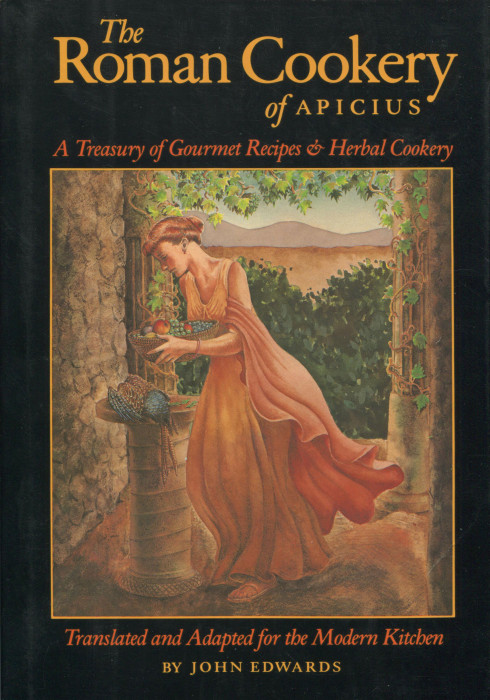Let’s say you have some lovely parsnips. How can you serve them? You can cook them in a mixture of water + white wine + olive oil + spices. Too bland? Find some sweet raisin wine, or muscatel. Use some parsnip stock instead of simple water. Which spices? Simple coriander and peppercorns, or perhaps an addition of rosemary and honey. Or cumin and rosemary and chives. Quite a battery of options.
And an old set of options. Two thousand years old. Today’s TBT Cookbook is The Roman Cookery of Apicius. This translation of a first century AD classic is by John Edwards and was translated in 1984 with the recipes given some modest revisions to suit more modern times. This volume has 360 recipes that were central to Roman cuisine. The origins of many Italian and French and Spanish dishes are to be found in the pages here.
Some of the chapters here are perfectly familiar to us: Fish, Shellfish, Vegetables, Poultry. But then there is a chapter called the Gourmet with those recipes for kidneys and lungs and sweetmeats, things we tend not to find in our supermarkets. Two thousand years can make a substantial difference. Here’s a sample of recipes, some easily recognizable and some quite foreign to us now. And, thanks to Apicius, all quite delicious:
Truffles in Coriander Wine Sauce, yes, the Romans knew all about truffles
Calf’s Brains with Egg Dumplings, the dumplings
Spiced Squash with Chicken and Apricots, with celery, truffles, caraway, cumin, ginger, and mint
Onion and Lettuce Puree in Lovage Mint Sauce
Rose Hips and Calf’s Brains Custard
Beans and Chicken Quiche with Cumin
Roast Duck in a Blanket of Turnips
Sweet Noon Sauce for Roasted Pigeons and Doves
Almond Ginger Stuffing for Chicken
Onion Date Sauce for Braised Meats
Spiced Celery Sauced for Truffles
Roast Pork with Cumin in Wines
Plum Sauce for Venison
Roast Suckling Pig with Garden Vegetables
Rosemary Sauce for Poached Skate
Date Sauce for Baked Tuna
Honey Mint Sauce for Bake Trout
Now, you are probably not going to run and buy some brains. But, you may enjoy, say, trout, although I doubt you have ever had trout with a Honey Mint Sauce. It’s the style here, sauce heavy, and the unusual combinations that make Roman Cookery so interesting. The sauces here are ones that truly give new dimensions to dishes: Lovage Mint, Sweet Onion, Onion Date, Spiced Celery, Date. Paging through the book today, I’ve scanned some non-brain recipes. I’m looking forward to my trout with that Honey Mint Sauce. And while Suzi and I don’t eat pigeon, that Sweet Onion Sauce is destined for a Cornish game hen.
This book is unquestionably a treasure chest for us. We can make the recipes exactly, we can mix and match. We can, for an evening, be just a little Roman and very well spiced at that. If you are a foodie, this book is worth paging through just to see how far we have come and how close, in many ways, we still are to our Western culinary roots.

